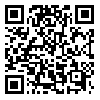Volume 17, Issue 1 (ُSpring 2022)
Salmand: Iranian Journal of Ageing 2022, 17(1): 28-43 |
Back to browse issues page
Download citation:
BibTeX | RIS | EndNote | Medlars | ProCite | Reference Manager | RefWorks
Send citation to:



BibTeX | RIS | EndNote | Medlars | ProCite | Reference Manager | RefWorks
Send citation to:
Nabavi S H, Asadi-Lari M, Mousavi M, Rashedi V, Fadayevatan R. The Multilevel Analysis of the Social Network in the Older Adults on the Urban-Heart 2. Salmand: Iranian Journal of Ageing 2022; 17 (1) :28-43
URL: http://salmandj.uswr.ac.ir/article-1-2184-en.html
URL: http://salmandj.uswr.ac.ir/article-1-2184-en.html
Seyed Hamid Nabavi1 

 , Mohsen Asadi-Lari2
, Mohsen Asadi-Lari2 

 , Mir-Taher Mousavi3
, Mir-Taher Mousavi3 

 , Vahid Rashedi1
, Vahid Rashedi1 

 , Reza Fadayevatan *
, Reza Fadayevatan * 
 4
4


 , Mohsen Asadi-Lari2
, Mohsen Asadi-Lari2 

 , Mir-Taher Mousavi3
, Mir-Taher Mousavi3 

 , Vahid Rashedi1
, Vahid Rashedi1 

 , Reza Fadayevatan *
, Reza Fadayevatan * 
 4
4
1- Department of Aging, Iranian Research Center on Aging, University of Social Welfare and Rehabilitation Sciences, Tehran, Iran.
2- Department of Epidemiology, Oncopathology Research Center, School of Public Health, Iran University of Medical Sciences, Tehran, Iran.
3- Social Welfare Management Research Center, University of Social Welfare and Rehabilitation Sciences, Tehran, Iran.
4- Department of Aging, Iranian Research Center on Aging, University of Social Welfare and Rehabilitation Sciences, Tehran, Iran. ,reza1092@yahoo.com
2- Department of Epidemiology, Oncopathology Research Center, School of Public Health, Iran University of Medical Sciences, Tehran, Iran.
3- Social Welfare Management Research Center, University of Social Welfare and Rehabilitation Sciences, Tehran, Iran.
4- Department of Aging, Iranian Research Center on Aging, University of Social Welfare and Rehabilitation Sciences, Tehran, Iran. ,
Abstract: (3339 Views)
Objectives Social network in older adults refers to interpersonal relationships and the perception of these relationships. Given the importance of the social network, the current study was conducted to answer three pivotal questions. First, do personal and regional factors affect the social network of the elderly? Second, how much share do the individual and regional factors have in the social network of the elderly? And third, which of these factors affect the social network of the elderly at each level of the personal and regional relationships.
Methods & Materials The study was conducted based on the second round of the Tehran city health equity and response tool (Urban-Heart 2). Thus, 5760 individuals (age <60 year) were selected from 22 urban regions in Tehran City. These data were then analyzed using the multilevel regression model.
Results The personal and regional levels explained about 89% and 11% of the social network of the elderlies, respectively. The individual factors explained 21% of the variance in the social network. Out of these parameters, age between 60 and 74, illiteracy, self-reported health, and mental health affected the social network significantly. At the regional level, the feeling of security, the control of corruption, the waiting time for bus arrival, and the sense of responsibility were the most influential factors explaining 19% of the variance in the social network.
Conclusion Not only is the social network of the elderlies affected by personal factors such as age, education level, and self-reported health and mental health, but it is also affected by regional factors (feeling of security, the control of corruption, the sense of responsibility, and waiting time for bus arrival). Although these regional factors are out of personal control, they can be improved for the elderly in society.
Methods & Materials The study was conducted based on the second round of the Tehran city health equity and response tool (Urban-Heart 2). Thus, 5760 individuals (age <60 year) were selected from 22 urban regions in Tehran City. These data were then analyzed using the multilevel regression model.
Results The personal and regional levels explained about 89% and 11% of the social network of the elderlies, respectively. The individual factors explained 21% of the variance in the social network. Out of these parameters, age between 60 and 74, illiteracy, self-reported health, and mental health affected the social network significantly. At the regional level, the feeling of security, the control of corruption, the waiting time for bus arrival, and the sense of responsibility were the most influential factors explaining 19% of the variance in the social network.
Conclusion Not only is the social network of the elderlies affected by personal factors such as age, education level, and self-reported health and mental health, but it is also affected by regional factors (feeling of security, the control of corruption, the sense of responsibility, and waiting time for bus arrival). Although these regional factors are out of personal control, they can be improved for the elderly in society.
Type of Study: Research |
Subject:
gerontology
Received: 2021/02/09 | Accepted: 2021/03/24 | Published: 2022/03/30
Received: 2021/02/09 | Accepted: 2021/03/24 | Published: 2022/03/30
Send email to the article author
| Rights and permissions | |
 |
This work is licensed under a Creative Commons Attribution-NonCommercial 4.0 International License. |





